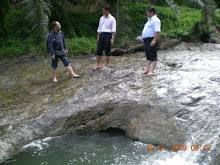 The children of the Sea Bajaus in most of the islands off the coast, between Kunak and Tawau are stateless. Stateless is a demographic term which defines a person as having no geographic state from which he or she originated from.
The children of the Sea Bajaus in most of the islands off the coast, between Kunak and Tawau are stateless. Stateless is a demographic term which defines a person as having no geographic state from which he or she originated from.Technically they are not Malaysian, even though they were born and raised on Malaysian soil/water. The Malaysian government doesn't recognize them as citizen. So are the other two neighboring governments.
With no citizenship, they therefore have no education, medical and employment benefits, making them totally hopeless on land.
Just like their fathers, grandfathers and forefathers,these young Sea Bajaus will continue living off and living on the sea.
Copy from : Trekearth.com by Rabani HMA


 Felda akan memulakan Projek Pengkulturan Rumpai Laut di daerah Kunak bermula tahun depan. Timbalan Menteri di Jabatan Perdana Menteri, Datuk Ahmad Maslan berkata, projek itu melibatkan rakyat daerah ini yang terdiri daripada golongan miskin dan miskin tegar.
Felda akan memulakan Projek Pengkulturan Rumpai Laut di daerah Kunak bermula tahun depan. Timbalan Menteri di Jabatan Perdana Menteri, Datuk Ahmad Maslan berkata, projek itu melibatkan rakyat daerah ini yang terdiri daripada golongan miskin dan miskin tegar.














 Panorama Pulau Bohayan
Panorama Pulau Bohayan
 Foto ini diambil pada 1983 di atas bangunan Singapore Trading kalau aku tak silap. Kelihatan bangunan pejabat Pos (a) seterusnya Klinik Kesihatan (b) yang pertama di pekan kunak sebelum berpindah ke JKR lama. Tangki simpanan CPO BAL Plantation (c) di Kg. Pangkalan, Masjid Lama Pekan Kunak (d) dan Panggung wayang (e).
Foto ini diambil pada 1983 di atas bangunan Singapore Trading kalau aku tak silap. Kelihatan bangunan pejabat Pos (a) seterusnya Klinik Kesihatan (b) yang pertama di pekan kunak sebelum berpindah ke JKR lama. Tangki simpanan CPO BAL Plantation (c) di Kg. Pangkalan, Masjid Lama Pekan Kunak (d) dan Panggung wayang (e). Kawasan semak samun di tepi Panggung wayang ini, sekarang telah didirikan premis bangunan rumah kedai dua tingkat yang diberi nama Bangunan Pangi. Kelihatan juga Ruamh pangsa balai polis Kunak sedang dalam pembinaan.
Kawasan semak samun di tepi Panggung wayang ini, sekarang telah didirikan premis bangunan rumah kedai dua tingkat yang diberi nama Bangunan Pangi. Kelihatan juga Ruamh pangsa balai polis Kunak sedang dalam pembinaan.

















